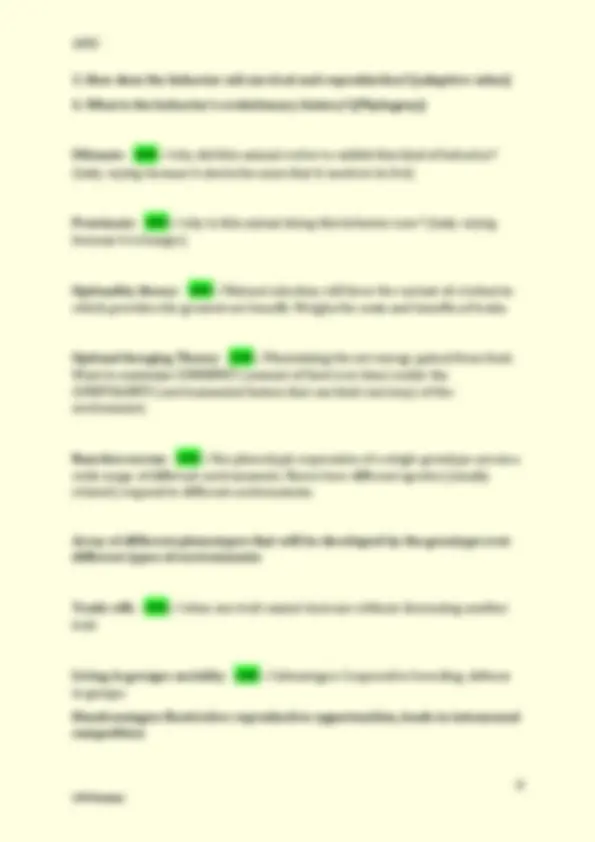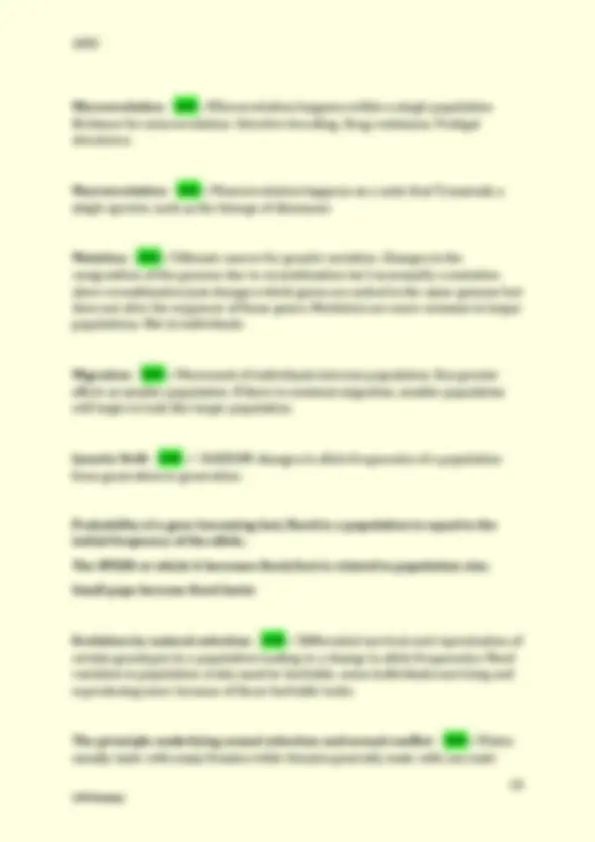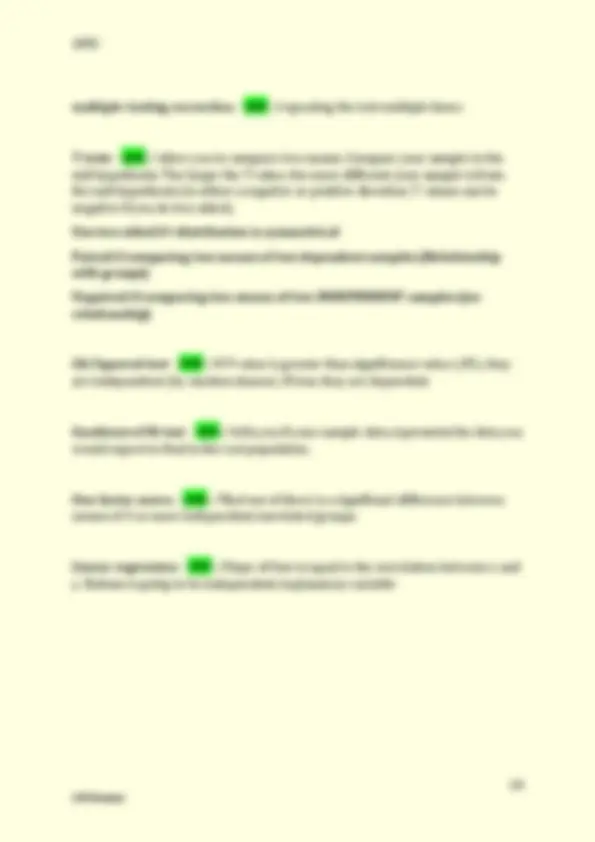










Study with the several resources on Docsity

Earn points by helping other students or get them with a premium plan


Prepare for your exams
Study with the several resources on Docsity

Earn points to download
Earn points by helping other students or get them with a premium plan
Community
Ask the community for help and clear up your study doubts
Discover the best universities in your country according to Docsity users
Free resources
Download our free guides on studying techniques, anxiety management strategies, and thesis advice from Docsity tutors
Sympatric speciation: - ANS ✓No physical geographic barrier Prezygotic barriers: barriers that form before you can even make a zygote. Behavioral isolation: different bird songs not attracting certain females Temporal isolation: breeding in different seasons or times Habitat isolation: One prefers an aquatic environment and one prefers terrestrial Postzygotic barriers: Offspring not able to develop Genetic incompatibility parapatric speciation - ANS ✓speciation pattern in which populations speciate while in contact along a common border. Environmental gradient formed where a hybrid is not favored Ecological Niche - ANS ✓N dimensional hypervolume which an individual can make a positive contribution to the next generation. How a population responds to the distribution of resources. The niche encompasses the ecological space which a species can consume resources as well as the pattern of resource use. The more similar the niche, the stronger the competition between species
Typology: Exams
1 / 14

This page cannot be seen from the preview
Don't miss anything!









Sympatric speciation: - ANS ✓No physical geographic barrier Prezygotic barriers: barriers that form before you can even make a zygote. Behavioral isolation: different bird songs not attracting certain females Temporal isolation: breeding in different seasons or times Habitat isolation: One prefers an aquatic environment and one prefers terrestrial Postzygotic barriers: Offspring not able to develop Genetic incompatibility parapatric speciation - ANS ✓speciation pattern in which populations speciate while in contact along a common border. Environmental gradient formed where a hybrid is not favored Ecological Niche - ANS ✓N dimensional hypervolume which an individual can make a positive contribution to the next generation. How a population responds to the distribution of resources. The niche encompasses the ecological space which a species can consume resources as well as the pattern of resource use. The more similar the niche, the stronger the competition between species. N Dimensional hypervolume where the dimensions are environmental conditions and resources required for a species to live its "way of life". (Hypervolume= multidimensional space of resources)
Interspecific competition - ANS ✓competition between 2 species (lions and hyenas competing for food) Intraspecific comp - ANS ✓competition between same species. (deer fighting for mate) Resilience - ANS ✓the capacity of an ecosystem to recover after a disturbance Minimum population - ANS ✓The minimum number of individuals of a population needed for that species to survive in the wild. Altruism - ANS ✓actor loses, receiver gains: selfless Mutualism - ANS ✓Both benefits. Obligate: Necessary to survive. Facultative: Not dependent Commensalism - ANS ✓One benefits, other is not affected Minimum population - ANS ✓The minimum number of individuals of a population needed for that species to survive in the wild. Metapopulation - ANS ✓Group of one species made up of spatially separated populations that interact on some level. Usually in fragmented habitats Key stone species - ANS ✓species who's influence on the environment is not proportional to its biomass Key stone ecosystems - ANS ✓ecosystem plummets as soon as biodiversity declines from natural levels
Communial (living in groups), quasisocial (takes care of young), semisocial (overlapping generations), Eusocial (division of labor and reproduction) Evolutionary arms race - ANS ✓Coevolving traits and counter adaptations Resource competition - ANS ✓Exploitation: Pops depress each other due to shared resource use Interference: individuals of one species prevent use of resource from another species Pre-emptive: Individuals occupy the resource, so it can be recycled by another Sex allocation - ANS ✓allocation of resources to males versus female reproduction Kin selection - ANS ✓natural selection in favor of behavior which might decrease an individual's fitness but increase their kin's fitness R selection - ANS ✓many offspring, little energy per offspring early maturity, short life span, unstable environment K selection - ANS ✓Little offspring, much energy per offspring, long lifespan, stable environment Carrying capacity - ANS ✓the maximum pop size an ecosystem can carry indefinitely Fecundity - ANS ✓maximum reproductive output Semelparity - ANS ✓: all offspring produced in single event (favored in stable and predictable environments)
Rarity 3: Restricted range, restricted tolerance, small pop size
Apomorphy: Shared DERIVED traits of one species or group, Synapomorphy refers to entire clades that have shared derived traits Genome - ANS ✓Genetic material of an organism Structure of genomes - ANS ✓Linear order of DNA elements and their division into chromosomes. Also the 3D structure of chromosomes and positioning of DNA sequences within the nucleus. Typical size of mammalian genome - ANS ✓3.5 billion base pairs of DNA How many protein coding genes are in the mammalian genome - ANS ✓30,000 protein coding genes in a typical mammalian genome Transcriptome - ANS ✓full range of messenger RNA or mRNA molecules expressed by an organism. Can be used to describe the array of mRNA transcripts produced in a particular cell or tissue type. Mendel's Law of Segregation - ANS ✓Lets us predict how a single feature associated with a single gene is inherited. When an organism produces a gamete, each gamete receives just one gene copy at random. Punnett square helps us predict the genotypes and phenotypes of an offspring from genetic crosses Independent assortment - ANS ✓states the alleles of two different genes get sorted in a gamete independently from one another (unless it is linked). Mendelian trait - ANS ✓trait controlled by one locus. The simplest trait
Microevolution - ANS ✓Microevolution happens within a single population Evidence for microevolution: Selective breeding, Drug resistance, Vestigal structures. Macroevolution - ANS ✓Macroevolution happens on a scale that Transends a single species: such as the lineage of dinosaurs Mutation - ANS ✓Ultimate source for genetic variation. Changes in the composition of the genome due to recombination isn't necessarily a mutation since recombination just changes which genes are united in the same genome but does not alter the sequence of those genes. Mutations are more common in larger populations. Not in individuals. Migration - ANS ✓Movement of individuals between population. Has greater effect on smaller population. If there is constant migration, smaller population will begin to look like larger population. Genetic Drift - ANS ✓: RANDOM changes in allele frequencies of a population from generation to generation. Probability of a gene becoming lost/fixed in a population is equal to the initial frequency of the allele. The SPEED at which it becomes fixed/lost is related to population size. Small pops become fixed faster Evolution by natural selection - ANS ✓Differential survival and reproduction of certain genotypes in a population leading to a change in allele frequencies. Need variation in population, traits must be heritable, some individuals surviving and reproducing more because of these heritable traits The principle underlying sexual selection and sexual conflict - ANS ✓Males usually mate with many females while females generally mate with one male
When two sexes have conflicting optimal fitness strategies Homology - ANS ✓Inherited from a shared ancestor: whale fingers and human fingers Analogy - ANS ✓result of convergent evolution: bat wings and bird wings Allopatric speciation - ANS ✓Geographic barrier allowing for geographic isolation. Earth quake separates one population into 2. Then they speciate. Gene flow is limited Haplotype - ANS ✓a group of genes present in an organism that was inherited together from a single parent. Inherited together as a pair from one chromosome from one parent. Due to genetic linkage. Inheritance of a cluster of genes on a single chromosome Genetic and environmental variance - ANS ✓When environmental variance is high, heritability is low. When environmental variance is low, heritability is high. Heritability = likelihood that phenotypic variation is due to genetics. Heritability - ANS ✓amount of phenotypic variation in a population that is due to genetic differences. Heritability is the ratio of variation due to genetics and the total phenotypic variation. Quantitative trait - ANS ✓Falls on a continuum determined by a large number of genes. Can change under environmental changes. Analyzed statistically Qualitative traits - ANS ✓Either present or not present. Like eye color. Do not change in response to environment. Discrete values can be analyzed with ratios.
Binomial distributions - ANS ✓the probability of success or failure Standard deviation - ANS ✓Find the mean. For each number, subtract the mean and square. Find the mean of those squared differences. Take the square root of that. Standard error - ANS ✓standard deviation divided by the square root of the sample size Scatter plot finding mean - ANS ✓max + min/ 2 Scatter plot - ANS ✓independent on bottom, dependent on right Boxplot - ANS ✓Minimum, 1st quartile, median, 3rd quartile, maximum Null hypothesis - ANS ✓There is no significant difference between specified populations Test statistic - ANS ✓a single measure of some attribute of a sample used in statistical hypothesis testing Significance level - ANS ✓Measure of strength of evidence needed to reject the null hypothesis. The probability of rejecting the null hypothesis when it is true. A .05 significance level indicates a 5% risk of concluding that a difference exists when there is no actual difference. Lower significance levels means you need stronger evidence to reject your null hypothesis. If P value is lower than your significance level, you can reject your null hypothesis and conclude that there is an actual difference. P value - ANS ✓probability of obtaining results as extreme as the observed results, assuming that the null hypothesis is correct. It needs to be smaller than the significance level to reject the null.
multiple-testing correction - ANS ✓repeating the test multiple times T tests - ANS ✓allow you to compare two means. Compare your sample to the null hypothesis. The larger the T value, the more different your sample is from the null hypothesis (in either a negative or positive direction. T values can be negative if you do two sided). Use two sided if t distribution is symmetrical Paired if comparing two means of two dependent samples (Relationship with groups) Unpaired if comparing two means of two INDEPENDENT samples (no relationship) Chi Squared test - ANS ✓if P value is greater than significance value (.05), they are independent (by random chance). If less, they are dependent Goodness of fit test - ANS ✓tells you if your sample data represents the data you would expect to find in the real population. One factor anova - ANS ✓Find out of there is a significant difference between means of 3 or more independent/unrelated groups. Linear regression - ANS ✓Slope of line is equal to the correlation between x and y. Bottom is going to be independent/explanatory variable